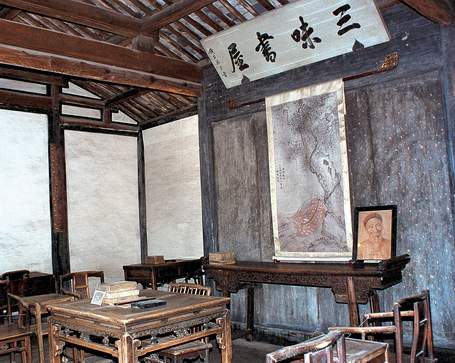Under the Beijing Sky

Houses aren’t in themselves melancholy – we read that emotion into empty spaces. Or, if we are fanciful, detect the residue of past disappointments. What is now the Lu Xun house museum near Fuchengmen in Beijing’s Xicheng District was his residence only from May 1924 to August 1926, the period at the end of his years in the city.
Earlier, in 1919 he had purchased a large compound in Badaowan, in the same district, where he lived with his extended family: his mother, wife, two brothers and their wives and children. He was particularly close to his middle brother, Zhou Zuoren, with whom he had studied in Tokyo and worked on translation projects. However, following a still unexplained rift between the brothers, Lu Xun moved into the Fuchengmen complex, where he lived with his mother and his wife, Zhu An.
His marriage was arranged, and was unsuccessful. The configuration of his new home reflected the isolation of these years. His mother and wife’s rooms are on the north side of a courtyard. Behind is a room Lu Xun used as his own bedroom and study, known affectionately as “the tiger’s tail.” It’s furnished simply and overlooks a small, secluded rear courtyard.
These were the years of the introspective, often melancholy prose poems collected in Wild Grass. On the New Year’s Day of 1925, he wrote: “My heart is extraordinarily lonely. But my heart is very tranquil, void of love and hate, joy and sadness, color and sound.” Alone in his study at night he looked up at the Beijing sky and found it strange and high. He dreamed he was running along a mountain of ice. He dreamed he was lying in a wilderness beside hell. He dreamed he was dead. His short stories of the period, published in the 1926 collection Wandering, so often dwell on the misunderstandings and unhappiness of marriage.
In his study are chairs provided for guests, one of whom was a young student at Beijing Women’s Normal College, Xu Guangping, who later became his partner. While happiness eluded Lu Xun in his family life, he was beginning to sense the possibility of an alternative way of living, quite apart from established norms. In his front courtyard are lilac trees he planted in April 1925. And in the courtyard overlooked by his study flourishes a yellow rose bush he planted at the same time. Its petals drift in the cracks between the flagstones.
That same month Xu Guangping visited “the tiger’s tail” for the first time, writing to Lu Xun afterwards: “My impression after returning home was of bright red lamps extinguished, and someone sitting in the room with glass windows all along one side, sometimes listening to the patter of rain, sometimes looking at the tranquil beauty of the moonlight...”
A Troubled Haven in Shanghai
Lu Xun and Xu Guangping left Beijing together in August 1926. Lu Xun had publicly condemned a violently suppressed student demonstration in March, resulting in his being blacklisted by Beijing’s warlord government. After a brief period in southern China where they lived separately, the couple moved to Shanghai in the autumn of 1927, and settled eventually in what was then Continental Terrace in Hongkou in April 1933. They lived there with their son Zhou Haiying, who had been born in 1929.
The three-storey red brick home is in a peaceful lilong, or lane, development, a traditional Shanghai building type. Now, as then, it is quiet and sheltered, second to the end in one of six uniform red brick rows. It was a home deliberately chosen for its seclusion and anonymity, and rented under another name. As an activist, proponent of revolutionary literature and friend to Communist writers and thinkers, Lu Xun was targeted by the Kuomintang government and periodically forced into hiding. Continental Terrace provided the family refuge during the last three years of his life.
After passing through the transitional space of the small, green courtyard, the home opens up to spacious, light-filled rooms hung with reproductions of paintings and woodcuts that reflected his artistic interests as a publisher of avant-garde prints.
This house museum foregrounds the intimacy of the small family unit; one of the most touching aspects is that the best lighted and airy room was given to his young son, whose photographs at various ages adorn the walls. His battered toys fill a bookcase. (If they are originals, someone was unable to bear the poignancy of discarding a jigsaw with missing pieces.) Lu Xun was nearly 50 when his only child was born; like most parents in these circumstances he doted on him.
Xu Guangping was a spirited and articulate woman, but the strongest picture that emerges of her through this home is her supportive role as wife and mother. There are reproductions of her embroideries, and in the museum in nearby Lu Xun Park are her hand-written recipes concocted to nourish husband and child.
After Lu Xun’s death from tuberculosis in 1936, Xu Guangping and her son left Continental Terrace. She kept the family’s effects, however, as well as Lu Xun’s manuscripts and books, which later became part of the Beijing Lu Xun Museum.
We recommend:
